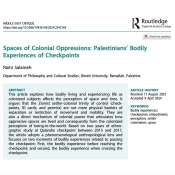Comment: Israeli closure of Ramallah for "security reasons" clearly untrue
Birzeit Public Relations Office staff member Nigel Parry argues that the alternative route to nearby Birzeit, in full view of numerous Israeli troops suggests a policy of collective punishment and a "safety valve" approach, and concludes by suggesting a difficult alternative.
Birzeit, 8 September 1997-- Since the latest bombing in Ben Yehuda pedestrian mall in Jerusalem last Thursday, the West Bank and Gaza Strip have once again been placed under full closure. In the West Bank, additional closures of roads in and out of Palestinian autonomous areas has caused massive disruption to everyday life.
In an interview on CNN's "Late Edition" on 10 August 1997, Israeli Prime Minister Benjamin Netanyahu stated that the reasons for the closure policy were as follows:
...[to] prevent the terrorists from coming and reaching the Israeli cities... These are not punitive measures.
The reality on the ground

The above map demonstrates that far from being closed, Ramallah is open. The checkpoint on the Birzeit-Ramallah road (marked above in orange), one of several around the city, is intended as a measure of collective punishment for the Palestinian population of the Ramallah area. The intersection of the settler road (marked in green above) that connects Beit El settlement to Tel Aviv in the west and the Ramallah-Birzeit road has traditionally become the northern point where Ramallah is sealed.
During the current closure, passage is denied to Palestinians in or out of Ramallah by an Israeli army checkpoint. However, a Palestinian can take a taxi on an alternative route (marked in red) to the north-east boundary of Ramallah and cross a concrete and earth barricade where a second taxi awaits. This exchange takes place in full view of an Israeli army watchtower 5 metres directly opposite. The waiting taxi pool at times numbers 20 cars, hardly an unnoticable number.
Once in the second taxi, a commuter to Birzeit passes within clear view of the main entrance to Beit El settlement, again past an Israeli army post along a stretch of road patrolled by Israeli jeeps. Opposite the entrance to Beit El, the taxi turns left and drives down the settler road to the point where it intersects the normal Ramallah-Birzeit route, finally turning right onto it within two metres of the Israeli army checkpoint, ostensibly there to seal off Ramallah.

It is not that the soldiers do not notice the cars are from Ramallah. The license plates of cars from Ramallah are marked clearly with an identifying mark from the city. In fact, during the last closure of Ramallah, Israeli soldiers at the checkpoint would even redirect cars with Ramallah plates which were trying to enter Ramallah, to this ad hoc route. This is, therefore, most certainly not a "security" closure as argued by Mr. Netanyahu.
Policies of closure
The provision of a "safety valve", to minimise the likelihood of clashes that would result from a total closure, is instrumental to Israeli closure policy and completely negates claims that the internal closure of West Bank towns such as Ramallah is for "security reasons". Entry to Jerusalem from the West Bank is similarly possible, via alternative routes, despite a closure that has been in force for four years since March 1993.
Clearly, with "closures" like these, a single bomber could enter and leave areas with freedom. However, goods in trucks cannot, at the cost of $9 million a day to the Palestinian economy. The conclusion one must draw is that these boundaries are fundamentally a political - not a "security" - tool for the purpose of putting pressure on the Palestinian population in the wake of terrorist attacks and for delineating the future boundaries of Palestinian autonomy particularly in the case of Jerusalem and its Al-Ram checkpoint.
The "Allon Plan Plus" final status plan recently put forward in Israeli circles follows this pattern. The "Allon Plan Plus" map, from the Foundation for Middle East Peace shows a larger version of the Ramallah-Birzeit situation, with four "Trans-Judean and Trans-Samarian highways" which can perform the same sealing function as the Beit El-Tel Aviv settler road. If this is indeed the future, it is not a future that offers any hope that the current situation will get any better.
In 1996, the Ramallah-Birzeit road was sealed 6 times, resulting in the loss of one-and-a-half months of Birzeit University's academic calendar. This year, over two weeks have already been lost with the current closure likely to add to this number. It is hard to understand who will benefit from such an obvious policy of collective punishment, proscribed by international law for good reason. Who, after all, will find time to consider the horror of a bomb attack on civillians if their daily life has been made into a misery of missed appointments, inability to travel to work, and an pervasive sense of confinement?
The international community, which should be confronting this issue with more determination, seems instead to be confused by the standard Israeli announcements during closures that they will be "gradually lifted" or "eased". In the wake of the Mahaneh Yehuda market bombing and immediate closure on 30 July 1997, the 1 September 1997 press release from the "Information Division" of the Israeli Ministry of Foreign Affairs (IMFA) entitled "IDF announces measures to ease closure" is revealed as misleading when viewed in the context of the last 4 years.
The figures quoted by the IMFA, relating to the 'lifting' of the August 1997 closure, say that 2,000 workers and 1,000 merchants from Gaza would be permitted to enter Israel to work, provided they are over 35 and 30 respectively, and married. In addition, 4,000 workers and 1,000 merchants will be allowed to enter from the West Bank. A total of 8,000? Big deal. Why does no one report that this figure is only a tiny proportion of the 120,000 that used to work inside Israel before the Israeli government-imposed closure of the West Bank and Gaza Strip in March 1993? It is not usually considered generous to take away a whole pie and give back a slice. Do not sigh with relief when CNN reports a lifting of a closure. We have got used to a dangerous status quo when we are relieved that less than one third of a percent of the Palestinian population have been "permitted" to exercise the human right to freedom of movement.
The future?
As long as the whole Palestinian population is subjected to collective punishment for the actions of a violent minority, Israel guarantees that there is unlikely to be any change in Palestinian attitudes towards the perpetrators. As long as Israel continues to unilaterally change facts on the ground - confiscating land, building settlements and demolishing Palestinian homes - sympathy for the victims of bombings is unlikely to be high. Repression creates radicalism. Radicalism without access to power mutates into political violence.
As long as Israel implements a racist and divisive ideology that deals with Jews and Arabs on two different scales there is also unlikely to be any change in the status quo. When was the last time you heard of a Jewish family home being demolished? When was the last time you heard about a Jewish prisoner dying mysteriously in detention? When was the last time you heard of a Jewish student being prevented from traveling to his or her university? What it this if it isn't base racism? During the current closure in which the Oslo 2 towns - 3 percent of the West Bank and Gaza land area - have become prisons for the 95 percent of the Palestinian population that live in them, Jewish settlers continue to have freedom of access around the West Bank. Apartheid did not work for South Africa so why should it work here? It can only serve as to prejudice the Palestinian population against Israel, Israelis and the idea of solving the conflict.
Mr. Netanyahu ran for office with the slogan "peace with security" but clearly does not understand that it is only peace itself that will bring true security. "Security" as he has practiced it does not even enforce a ceasefire. It merely consists of the same old repressive practices that have characterised the Israeli occupation, tools used by both Labour and Likud governments. It follows the same old attempts to secure - in this conflict that ultimately hinges on land - a checkmate on the ground using settlements as chess pieces. It is obvious that this widely disruptive closure is useless in security terms as no real attempt is being made to hermetically seal the West Bank. Based on this and with the encouragement of accompanying negative Israeli policies, of course the bombings will continue, and the government of Israel looks more and more likely to use them as an excuse to violate and possibly discard the Oslo accords. How coincidental.
The real issue is therefore conveniently ignored. Real peace will require real compromise by an Israeli government, with all the parties in Palestine, not just the most powerful Palestinian faction as was clearly the case in the Oslo accords. Dialogue with Hamas remains the most difficult nettle to be grasped. This fact has always been true and is not unknown to the Israeli side. I remember speaking with some HAMAS activists in 1996, who were seriously discussing the possibility of accepting a peace deal with Israel in exchange for the West Bank, Gaza Strip and East Jerusalem in their entirety and living alongside the State of Israel, rather than the traditional demand for the return of all of historic Palestine. I do not believe this is, as some Israeli sources claim, a tactic. Instead of exploring this route, Israel prefers to retain the impossible goal of ultimate Israeli sovereignty over the whole of Palestine, a sure recipe for the continuation of this potentially endless conflict.






